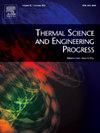Numerical calculation and analysis of a novel heat pipe type proton exchange membrane fuel cells
IF 5.1
3区 工程技术
Q2 ENERGY & FUELS
引用次数: 0
Abstract
The design of the thermal management system for proton exchange membrane fuel cells (PEMFC) is crucial for ensuring safe operation. Our research team developed a heat dissipation system for PEMFC using a micro heat pipe array (MHPA-PEMFC). The incorporation of MHPA has enhanced the cooling capacity of the stack and improved the temperature uniformity inside the stack. This study employs numerical simulations to evaluate the thermal and electrochemical performance of the proposed heat pipe-type PEMFC under various operating conditions. A mathematical model of the novel MHPA-PEMFC is established based on a lumped parameter method. Then, the impact of cooling and reaction air flow rates on the electrical and thermal properties of MHPA-PEMFC were analyzed with the mathematical model, and the optimal air flow rate control range under various operating conditions is summarized. When the thermal performance of the stack simultaneously satisfies the maximum temperature and maximum temperature difference requirements, the corresponding reaction air flow rate and cooling air flow rate for maximum output power are 0.05 m3/s and 0.04 m3/s, respectively. At these flow rates, the maximum and net output powers are 968.6 W and 937.6 W, respectively. The research findings provide technical support for the optimized operation of MHPA-PEMFC.
新型热管型质子交换膜燃料电池的数值计算与分析
质子交换膜燃料电池(PEMFC)热管理系统的设计是保证其安全运行的关键。本研究团队利用微热管阵列(MHPA-PEMFC)开发了一种用于PEMFC的散热系统。MHPA的加入提高了烟囱的冷却能力,改善了烟囱内部的温度均匀性。本研究采用数值模拟的方法对所提出的热管型PEMFC在不同工况下的热学和电化学性能进行了评价。基于集总参数法建立了新型MHPA-PEMFC的数学模型。然后,利用数学模型分析了冷却和反应风量对MHPA-PEMFC电学和热学性能的影响,总结了不同工况下的最佳风量控制范围。当堆热学性能同时满足最高温度和最大温差要求时,对应的最大输出功率反应风量为0.05 m3/s,冷却风量为0.04 m3/s。在此流量下,最大输出功率为968.6 W,净输出功率为937.6 W。研究结果为MHPA-PEMFC的优化运行提供了技术支持。
本文章由计算机程序翻译,如有差异,请以英文原文为准。
求助全文
约1分钟内获得全文
求助全文
来源期刊

Thermal Science and Engineering Progress
Chemical Engineering-Fluid Flow and Transfer Processes
CiteScore
7.20
自引率
10.40%
发文量
327
审稿时长
41 days
期刊介绍:
Thermal Science and Engineering Progress (TSEP) publishes original, high-quality research articles that span activities ranging from fundamental scientific research and discussion of the more controversial thermodynamic theories, to developments in thermal engineering that are in many instances examples of the way scientists and engineers are addressing the challenges facing a growing population – smart cities and global warming – maximising thermodynamic efficiencies and minimising all heat losses. It is intended that these will be of current relevance and interest to industry, academia and other practitioners. It is evident that many specialised journals in thermal and, to some extent, in fluid disciplines tend to focus on topics that can be classified as fundamental in nature, or are ‘applied’ and near-market. Thermal Science and Engineering Progress will bridge the gap between these two areas, allowing authors to make an easy choice, should they or a journal editor feel that their papers are ‘out of scope’ when considering other journals. The range of topics covered by Thermal Science and Engineering Progress addresses the rapid rate of development being made in thermal transfer processes as they affect traditional fields, and important growth in the topical research areas of aerospace, thermal biological and medical systems, electronics and nano-technologies, renewable energy systems, food production (including agriculture), and the need to minimise man-made thermal impacts on climate change. Review articles on appropriate topics for TSEP are encouraged, although until TSEP is fully established, these will be limited in number. Before submitting such articles, please contact one of the Editors, or a member of the Editorial Advisory Board with an outline of your proposal and your expertise in the area of your review.
 求助内容:
求助内容: 应助结果提醒方式:
应助结果提醒方式:


